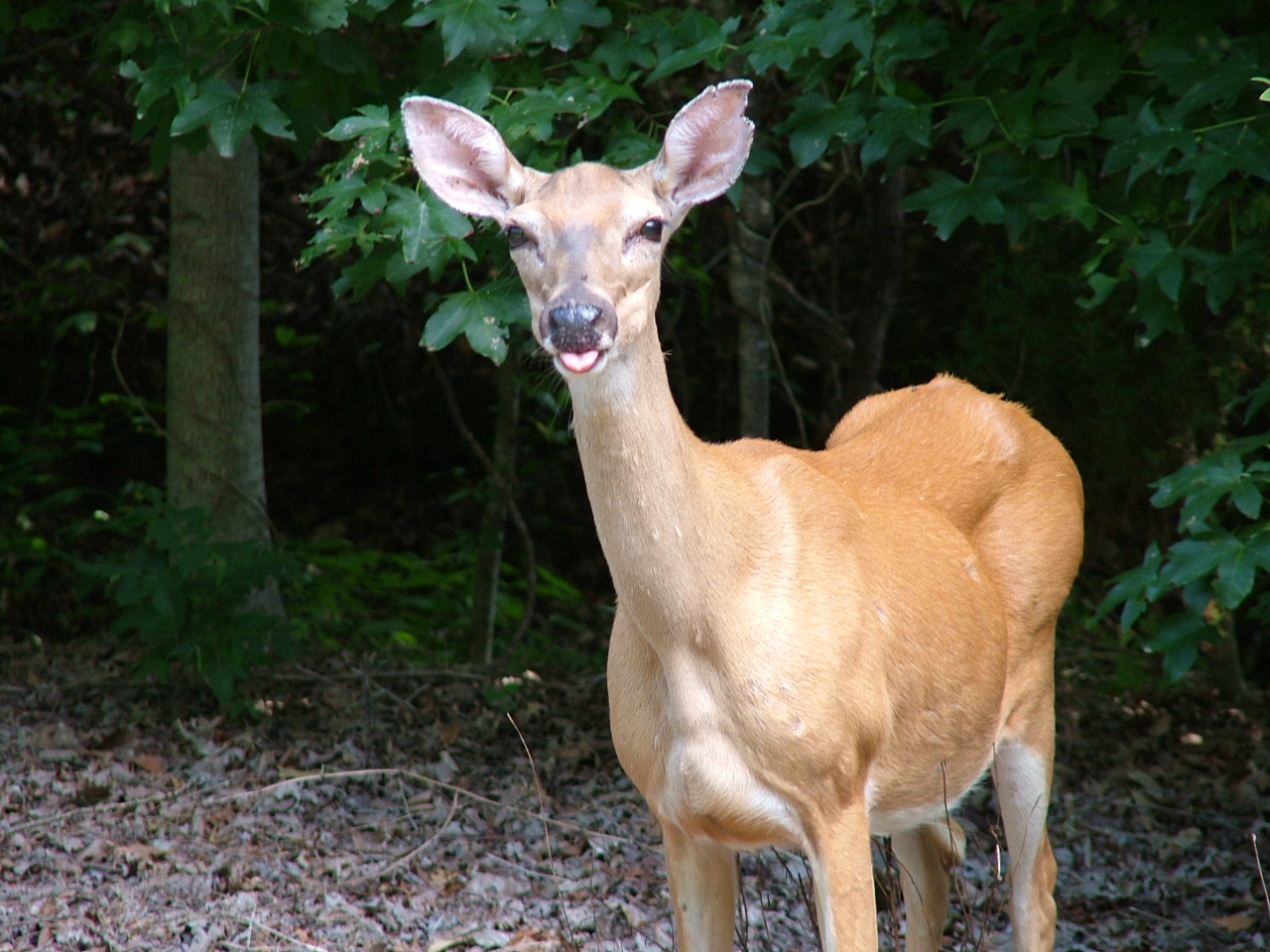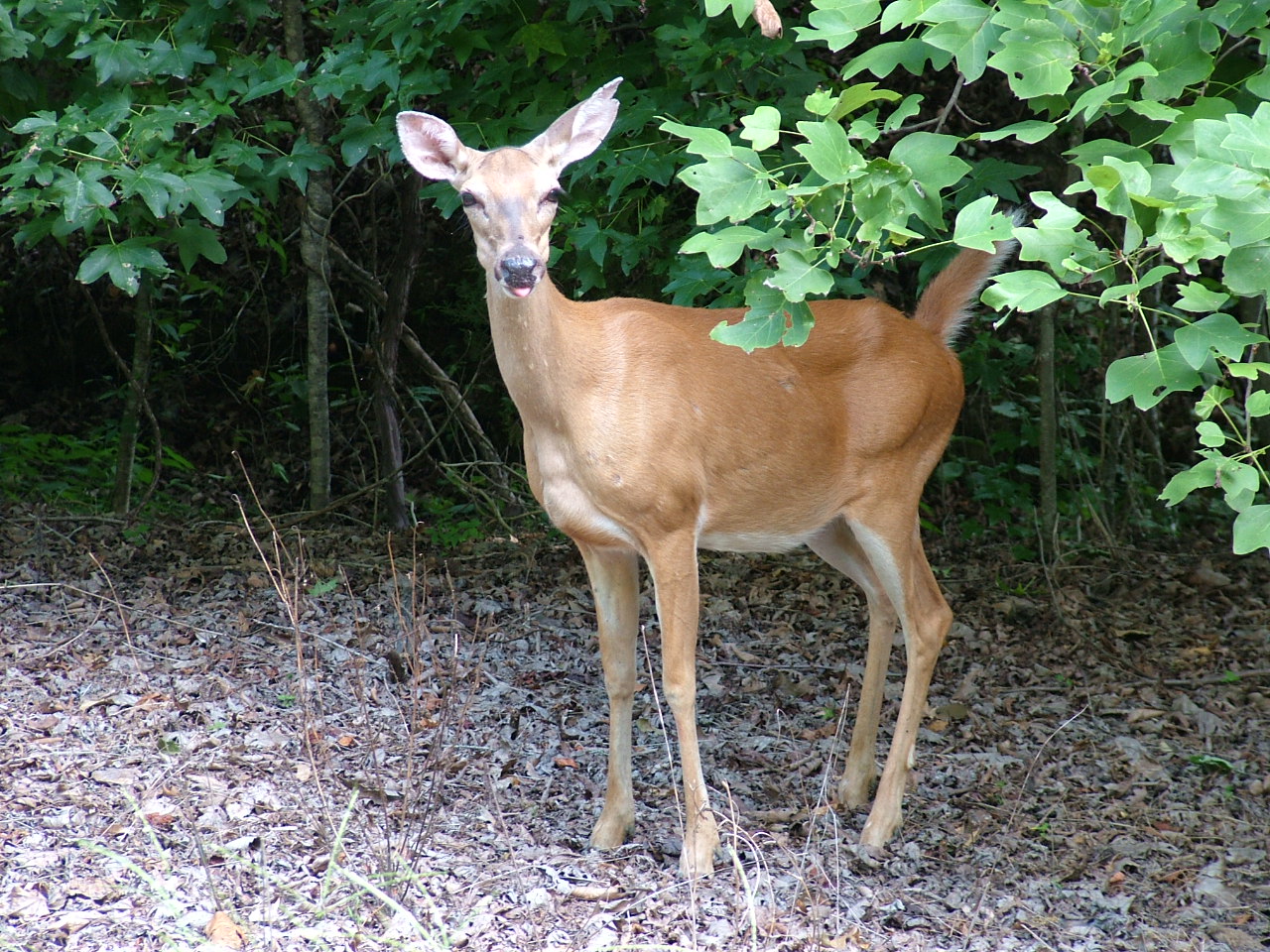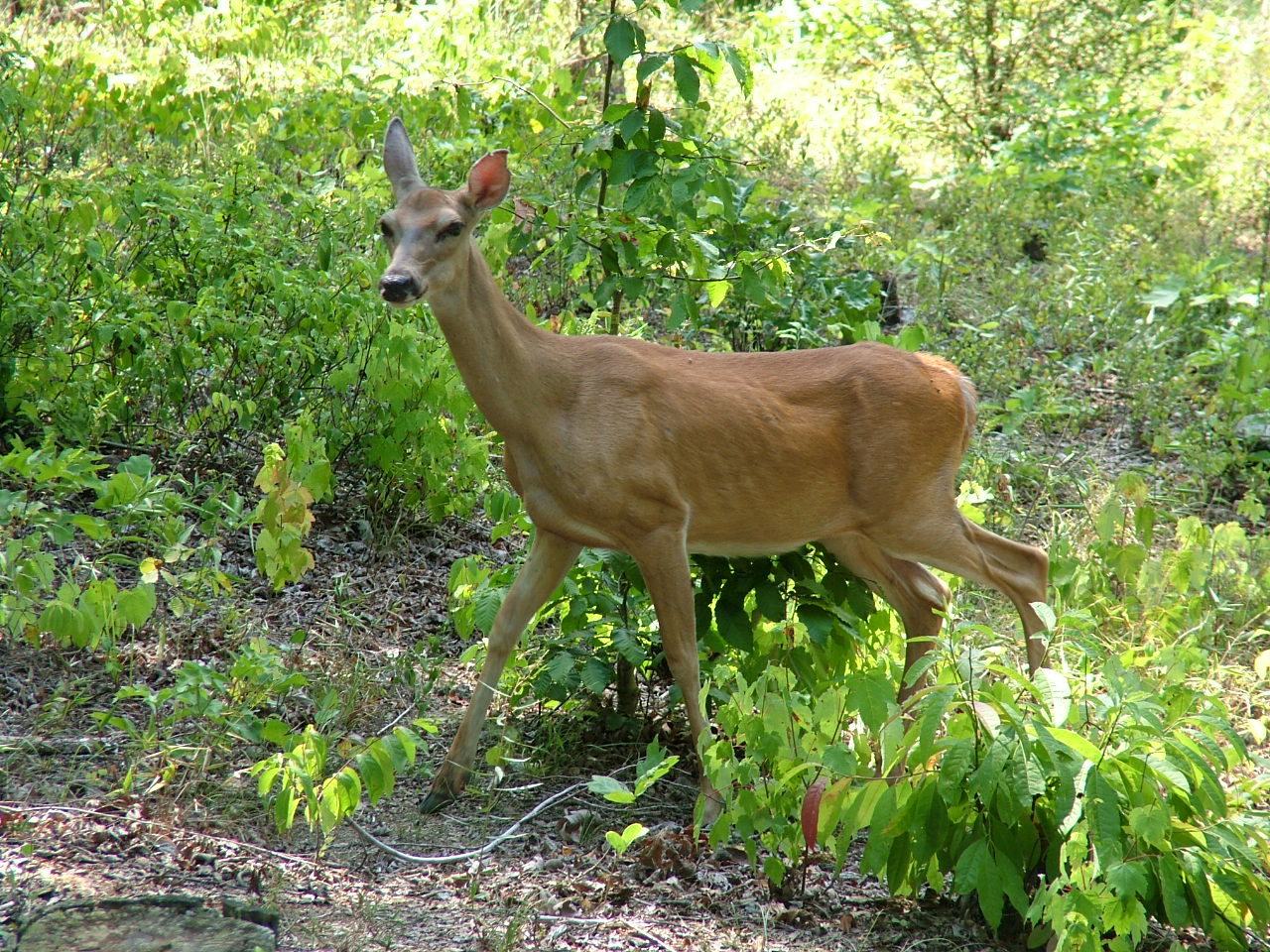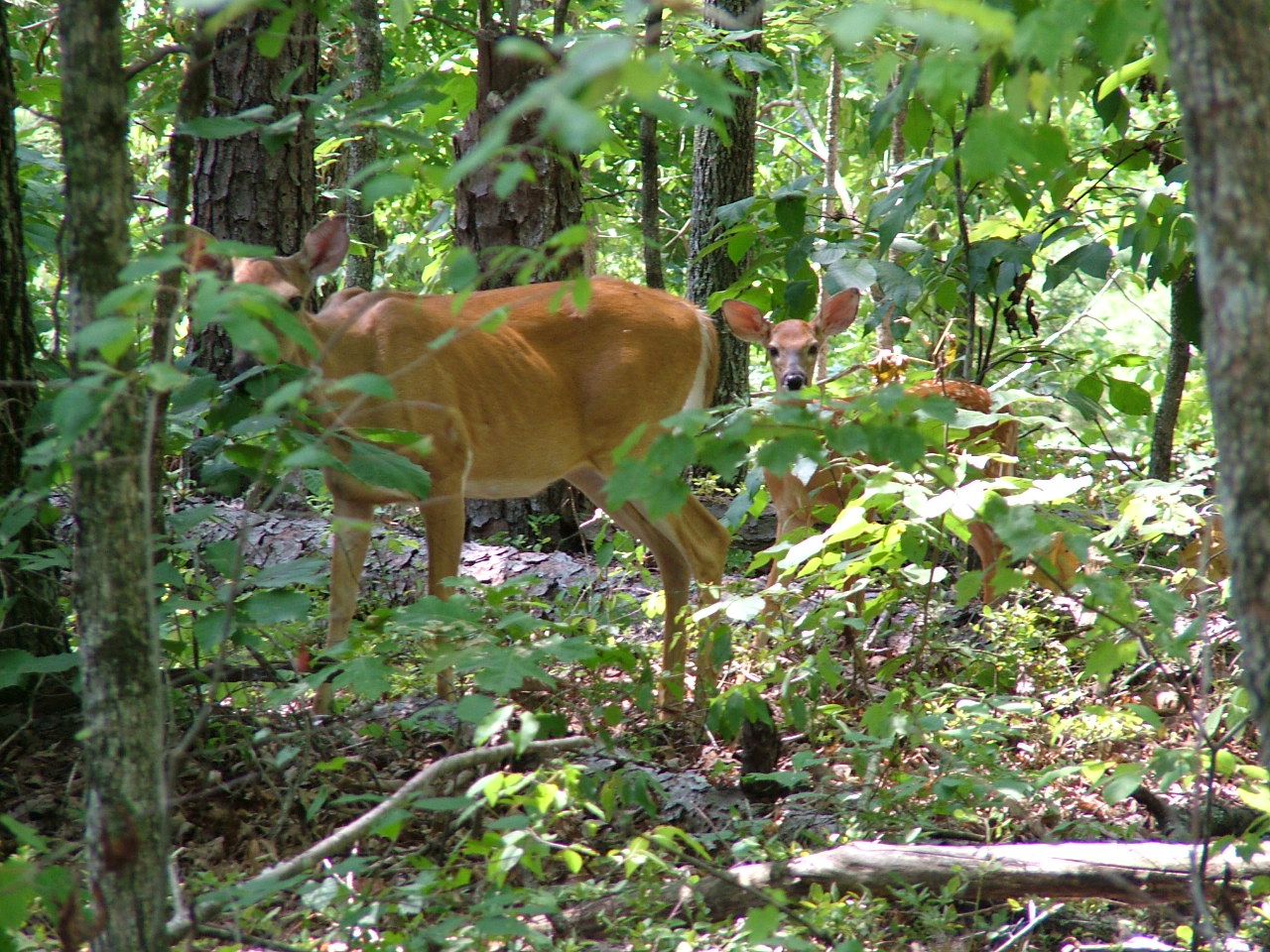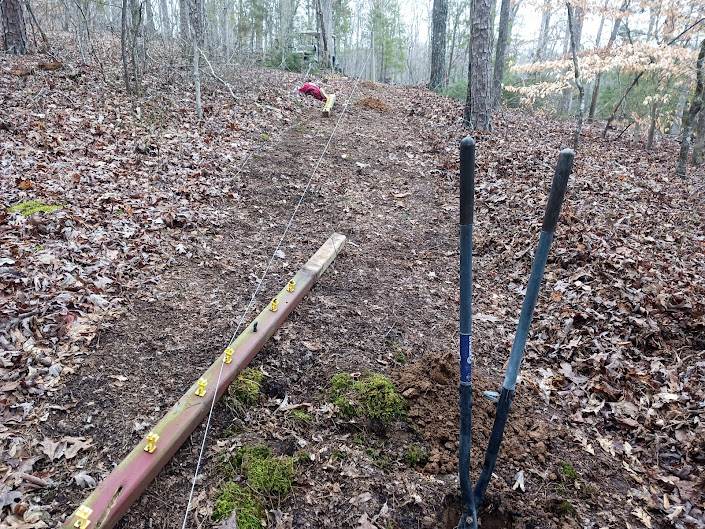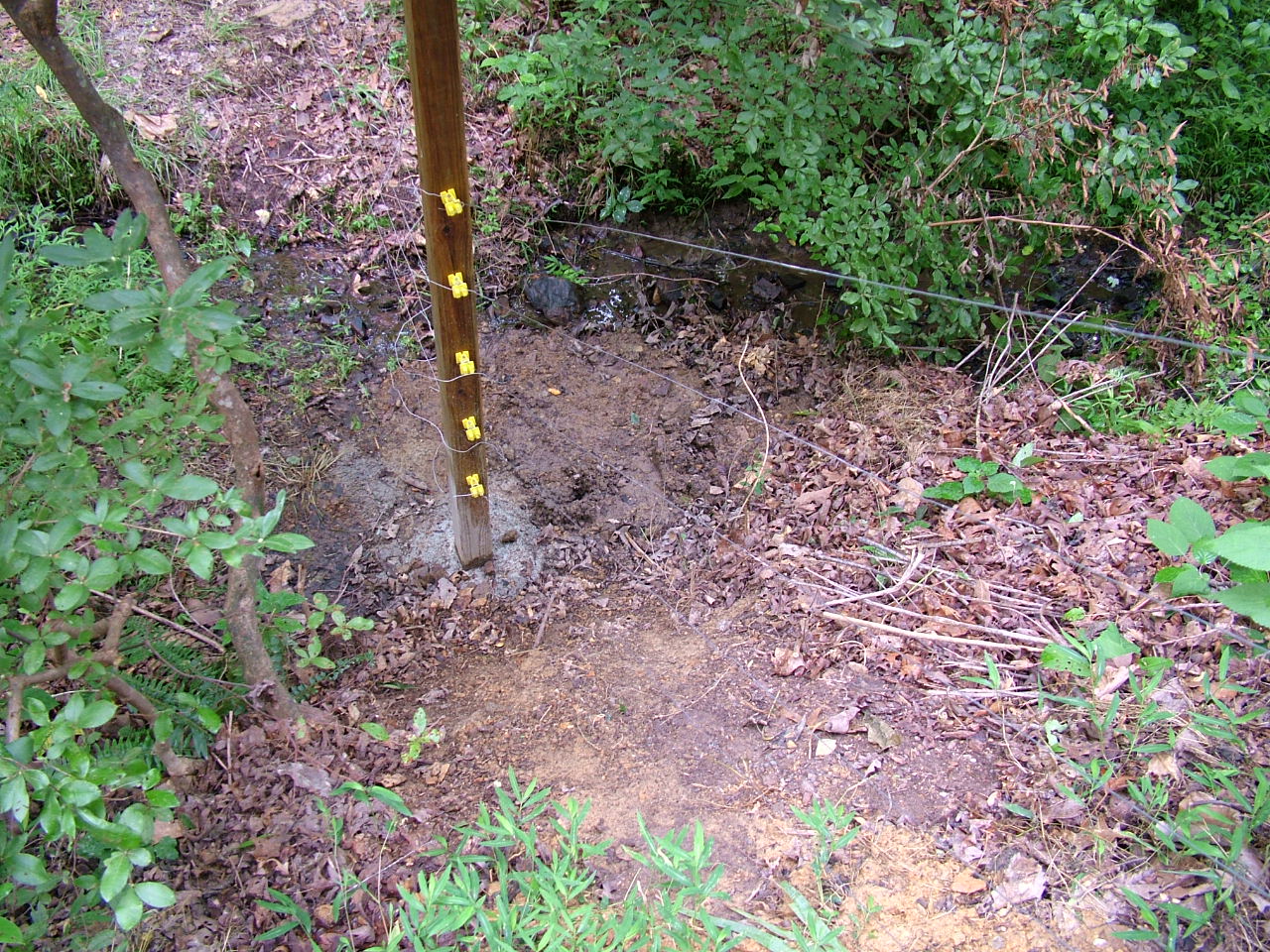A Close Encounter
There are many food and water sources in the Hollow so wildlife here is abundant. I have not taken very many pictures of wildlife here due to the difficulty of wildlife photography. However, an unusual event happened here in 2007 during a severe drought. A doe came down to our Daylily and Hosta houses looking for food while I was there. She was very skinny and had recently had a fawn. I was able to get these photos and when I followed her into the surrounding woods I also was able to photograph her with her fawn.
Mammals
- White Tail Deer-We are overrun here with Deer. We currently have a Doe with three fawns using the East end of Hollow and for a primarily forested area, we have one of the highest deer populations in Tennessee. We use several methods to repel deer. We have installed several miles of Electric Fencing to keep Deer out of the main Garden area. We also use Milorganite to repel them from eating various plants and Motion Activated devices to scare them.
- Black Bear-They have been spotted in or near the Hollow but this is rare.
- Red Fox-They have been spotted many times in person or on trail cameras.
- Gray Fox-They have been spotted many times in person or on trail cameras.
- Coyote-Haven't seen any personally but hear them in the Hollow frequently.
- Raccoon-They are abundant in the Hollow due to the water and food sources here.
- Virginia Opposum-They are abundant in the Hollow due to food sources.
- Gray Squirrel-They are abundant in the Hollow due to food sources and numerous hollow trees.
- Flying Squirrels-They are abundant in the Hollow due to food sources and numerous hollow trees.
- Chipmunks(Tamias)We have seen them here on occasion.
- Turkey-They are abundant due to the great quantity of mast, our daylily field, and nearby grass fields. We find that they like the trails in the Hollow. This is because of the back slope above the trail. The back slope traps leaves and debris at the bottom and worms and other insects hide there. Turkeys will travel along the trail turning over this debris to search for food.
- Appalachian Cottontail-There are only a few Cottontails near the entrance to the Hollow. This is due to a lack of habitat and the Hawk and Owl population.
- Woodchuck-Several dens of Woodchucks exist in the Hollow.
- Muskrat-Muskrats are nuisances in and around the three ponds and the three-acre lake.
- Striped Skunk-Definitely present!
- Voles, Moles, Shrews, Rats, and Mice-We have all of these in abundance.
- Bats-The hollow trees here provide great nesting sites for Bats. They emerge in the evening to feed on insects in the open areas in the Hollow and around the ponds and Lake.
Snakes, Reptiles, and Salamanders
The ones that I have seen and identified here while working or exploring are listed. I'm sure there may be others that occur in the Hollow.
1. Eastern Wormsnake, Carphophis amoenus
2. North American Racer(Coluber constrictor)
3. Northern Ring-necked Snake(D. p. edwardsii)
4. Gray Ratsnake(Pantherophis spiloides)
5. Eastern Hog-nosed Snake(Heterodon platirhinos )
6. Common Kingsnake, Lampropeltis getula
7. Common Watersnake(N. s. sipedon)
8. Eastern Gartersnake (T. s. sirtalis) ,
9. Northern Copperhead (A. c. mokasen)
10. Timber Rattlesnake(Crotalus horridus)
11. Eastern Smooth Earthsnake(Virginia valeriae)
12. Spotted Salamander(Ambystoma maculatum)
13. Red Salamander(Pseudotriton ruber)
14. Eastern Snapping Turtle (C. s. serpentina)
15. Eastern Box Turtle(Terrapene carolina)
Birds
- Great Blue Heron(Ardea herodias) The Hollow has a resident Great Blue Heron that spends time fishing between the lake, three ponds and even the Creek.
- Belted Kingfisher(Megaceryle alcyon) I see these every year fishing in the Lake.
- Osprey(Pandion haliaetus)Have seen these come in a couple of times and it was a truly awesome experience.
- Wood Duck(Aix sponsa) These come through sporadically.
- Mallard(Anas platyrhynchos) We see them several times a year.
- Red Tailed Hawk(Buteo jamaicensis) There are three Red Tails that split the Hollow in sections, occasionally getting into high altitude screeching fights.
- Pileated Woodpecker(Dryocopus pileatus) I see and hear them in the forest pecking for insects and making their self identifying call.
- White-breasted Nuthatch(Sitta carolinensis) Always present at our bird feeder in the Spring.
- American Goldfinch(Spinus tristis ) See these at our bird feeder and flocks in the woods.
- House Sparrow(Passer domesticus ) These make nests around our Bakery and other places and are seen year round.
- House Finch(Haemorhous mexicanus) We see these at our bird feeder on a regular basis
- Brown Headed Cowbird(Molothrus ater ) They come into the feeders in late Spring and just eat and eat.
- Common Grackle(Quiscalus quiscula) We rarely see these due to the hawks in the area.
- Red Winged Blackbird(Agelaius phoeniceus ) These are fairly rare but see them in the Spring sometimes.
- Indigo Bunting(Passerina cyanea ) These don't come near the house but I see them near the trails where there is abuntant plant growth. They eat the seeds produced by the plants that grow there.
- Rose-breasted Grosbeak(Pheucticus ludovicianus ) An uncommon visitor but a real pleasure in the Spring.
- Northern Cardinal(Cardinalis cardinalis )
- Dark Eyed Junco(Junco hyemalis )
- White Throated Sparrow(Zonotrichia albicollis )
- Eastern Towhee(Pipilo erythrophthalmus )
- Scarlet Tanager(Piranga olivacea )
- Northern Mockingbird(Mimus polyglottos )
- American Robin(Turdus migratorius )
- Wood Thrush(Hylocichla mustelina )
- Chimney Swift(Chaetura pelagica )
- Eastern Bluebird(Sialia sialis)
- Carolina Wren(Thryothorus ludovicianus )
- Tufted Titmouse(Baeolophus bicolor )
- Barn Swallow(Hirundo rustica )
- Tree Swallow(Tachycineta bicolor )
- American Crow(Corvus brachyrhynchos)
- Blue Jay(Cyanocitta cristata )
- Red-bellied Woodpecker (Melanerpes carolinus )
- Ruby-throated Hummingbird, Archilochus colubris
- Red-headed Woodpecker(Melanerpes erythrocephalus)
- Eastern Whip-poor-will(Antrostomus vociferus)
- Chimney Swift(Chaetura pelagica)
- Chuck-will's-widow(Antrostomus carolinensis)
- Eastern Screech-Owl(Megascops asio)
- Barred Owl(Strix varia)
- Bald Eagle(Haliaeetus leucocephalus)
- Turkey VultureCathartes aura)
- Mourning Dove(Zenaida macroura)
- Wild Turkey(Meleagris gallopavo)

